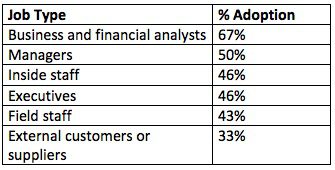New technologies and business imperatives are about to drive much deeper use of business intelligence and analytics tools, posing a substantial challenge to IT departments responsible for supporting those users and those applications.
New survey data and interviews indicate that IT departments should seriously reconsider the way they support and train BI users if they hope to show a favorable return on investment from these tools, as well as from IT budgets and salaries in general – not to mention retaining their sanity.
The “2012 Successful BI Survey: Best Practices in Business Intelligence for Greater Business Impact” from BI Scorecard estimates that roughly 24 percent of the employees at a typical company use BI or analytics tools. That percentage hasn’t changed much in the past several years. And it’s close enough to the Gartner estimate of 28 percent that it’s clear the tools have not made deep inroads. Indeed, BI Scorecard’s survey respondents indicated that penetration levels would go to 54 percent if cost, technology and other institutional challenges were not barriers to increased use.
BI/analytics’ use may be far deeper than the surveys show, though. Actual penetration is hard to determine for a variety of reasons, including the fact that most of these surveys primarily rely on IT respondents who are typically unaware of cloud and departmental BI implementations.
In addition, there is the much broader use of BI and analytics over the past several years, such as in HR, supply chain and other departments outside of the traditional finance and marketing BI domains.
However, the new BI Scorecard survey includes fascinating data and trends that indicate deeper use within departments. Consider that roughly two thirds of analysts and half of the managers of the respondents’ organizations are using BI (see table):
Source: 2012 Successful BI Survey: Best Practices in Business Intelligence for Greater Business Impact, BIScorecard
BI Scorecard founder and 20-year BI veteran Cindi Howson, who wrote the report, notes that “while 43 percent was the adoption rate for field staff in 2012, it was 33 percent in 2009. And the adoption rate for external customers and suppliers was 16 percent in 2009 but increased to 33 percent by last year.” (The 2012 survey included 634 respondents from mostly U.S. companies and was conducted from June through September 2012.)
Howson and others focus on several technology and business trends as the drivers of the growing increase in penetration rates. The sharply growing number of use cases is a key reason.
“The real potential is 100 percent,” Howson contends. “I have done case studies that show real potential benefits for almost all employees. While most of the stakeholders still say 54 percent, that number will change as people are starting to see more potential.”
Another major spur to increased penetration is the rise of BI and analytics delivered via a tablet. While many sales people, executives and others have been using smartphones to access BI reports for years, tablets’ combination of more powerful processor, far more memory, bigger display form factor and touchscreen technologies enable new applications. And those new applications feed more mobile BI use in a virtuous cycle that has only begun to appear.
“All of a sudden, it is realistic for mobile workers to use BI to make decisions without a support person,” notes Jeff Boehm, vice president for global product marketing at Qlikview, one of the fast growing players in the data discovery part of the BI/analytics market.
And he’s not talking about the typical scenario of a sales person calling on a prospect. Sales clerks checking inventory, truck drivers seeking optimum pick-up and delivery routes and other job categories are quickly expanding the definition of knowledge workers who can profit from mobile BI/analytics.
What about the cost?
The costs of BI also are changing. A decade ago a per-user license cost with four digits was not uncommon, especially for the power users. The rise of cloud-based BI, accessible via mobile devices, and the occasional BI user made the one-size-fits-all model untenable.
As Boehm notes, Qlikview and other vendors now offer a range of pricing models with far lower costs for infrequent users. As a result, he estimates that the ratio of light to heavy users ranges from 4:1 to 15:1 among his customers. “At some companies, almost everyone is a named user.”
And that brings up the challenge and opportunity for the IT department. Heretofore the biggest barrier to more widespread use of BI and analytics was the IT department, according to Howson. “IT has such a backlog of requests to service the installed base. To increase usage, organizations have to remove IT as the bottleneck. “
Qlikview’s Boehm is quick to offer a prescription for the IT headache: “There needs to be a shift in the mindset at IT. IT should focus on empowering users, not being report writers. They should get out of the role of the nanny feeding the children. Instead, they need to enable users to use the tool themselves. “
In the current environment, when business needs change in less time than it takes for another article to appear about the promise of Big Data, IT has to stop being the creator of reports. “There is less and less value in prepackaged reports these days,” Boehm adds. “Instead, IT should be a powerful partner, creating a foundation for users to exploit.”
Well, vendors and IT managers have been talking about BI self-service for many years and success has been spotty. Boehm recommends that IT and the business side form a partnership to redefine training as the pre-requisite for self service.
“In the old days, organizations would train the business users on the quirks of the tools. They should focus on training individuals on the specific apps that relate to their business problems,” Boehm explains.
Sign me up.



